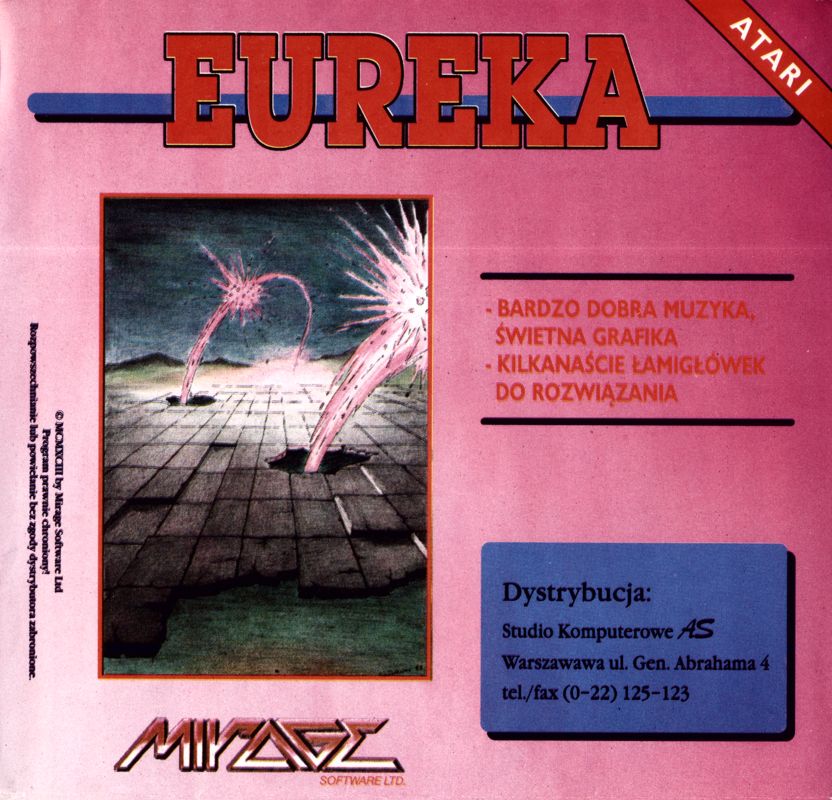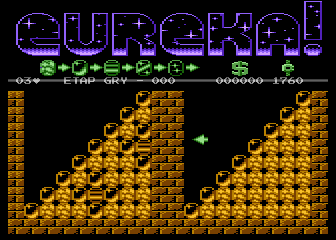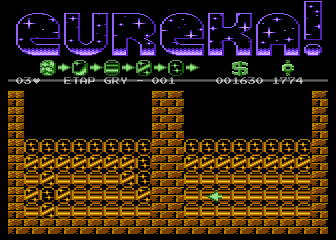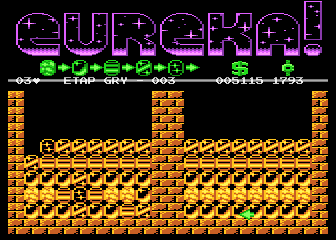Retro Replay Review
Gameplay
Eureka’s core gameplay is built around a deceptively simple mechanic: arranging a grid of colorful gems into precise patterns. The target design is displayed on the left side of the screen, while the player’s current gem layout sits on the right. By clicking on a gem, you cycle it through a sequence of available colors before it finally vanishes, causing the gems above to cascade downward. This mechanic alone offers surprising depth, as each decision sets off a chain reaction that reshapes the entire board.
(HEY YOU!! We hope you enjoy! We try not to run ads. So basically, this is a very expensive hobby running this site. Please consider joining us for updates, forums, and more. Network w/ us to make some cash or friends while retro gaming, and you can win some free retro games for posting. Okay, carry on 👍)
Adding another layer of strategy, each click also affects the four adjacent gems—cycling them forward by two color steps. This interplay between single-gem manipulation and multi-gem shifts forces players to think several moves ahead. One misguided click can ripple through the grid, potentially throwing your carefully planned design into disarray. As you progress, you’ll encounter increasingly intricate patterns that require precise timing and spatial reasoning to solve.
With 50 levels on offer, Eureka strikes a satisfying balance between fresh challenges and gradually increasing difficulty. Each level introduces new design elements or tighter time constraints, keeping the gameplay loop engaging. A visible timer creates a sense of urgency: let it run out, and you lose one of your three lives and restart the level. You can also press Space to reset a level immediately if you realize your current moves are futile—but doing so also costs a life, encouraging efficient problem-solving rather than brute-force resets.
Graphics
Eureka’s visual style is clean and functional, prioritizing clarity over flash. Each gem type is represented by a distinct shape and color, making it easy to distinguish between them at a glance. The left-side target pattern is rendered in crisp vector lines, while the right-side puzzle grid uses slightly more polished, gem-like sprites that catch the light when they fall or disappear. This minimalistic design ensures that your eyes focus on the puzzle itself without unnecessary visual distractions.
The user interface complements the core visuals with a straightforward layout. Above the game grid, a small indicator shows the sequence of gem colors, helping you anticipate how many clicks are needed to reach a desired color. Animations—including the satisfying ‘pop’ when a gem cycles and the smooth drop of gems after a disappearance—add just enough polish to make each move feel weighty and impactful. There’s a pleasing rhythm to the shifting gems, enhanced by subtle sound effects that reinforce each action.
While Eureka doesn’t push graphical boundaries with 3D effects or high-resolution textures, it benefits from a consistent art style that scales well across different screen sizes. Whether you’re playing on a small laptop display or a large desktop monitor, the clean lines and bold colors remain legible. Backgrounds are kept intentionally subdued—often muted gradients or simple patterns—so that they never compete with the puzzle grid for your attention.
Story
Eureka doesn’t present a traditional narrative with characters or plot twists. Instead, it offers a thematic journey through fifty distinct gem-based designs, each more elaborate than the last. While you won’t find cutscenes or dialogue, the progression of patterns—from simple symmetrical shapes to ornate, interlocking configurations—creates a subtle sense of advancement and purpose.
If you’re someone who craves a storyline to provide context for your challenges, you may find the minimalist approach here refreshing or underwhelming, depending on your tastes. On the one hand, the absence of narrative distractions allows you to dive straight into the puzzles and measure your own improvement. On the other hand, players seeking emotional investment or character-driven motivation may miss having a storyline to guide their experience.
In lieu of a traditional plot, Eureka uses the satisfaction of pattern completion and escalating complexity to keep you engaged. Each completed level reveals the next gem design, giving a small but tangible reward for your efforts. This silent storytelling—told through shapes, colors, and the quiet triumph of a well-executed solution—will appeal to purists who believe that the best narratives in puzzle games are the puzzles themselves.
Overall Experience
Eureka delivers a polished, focused puzzle experience that will resonate with fans of logic-based challenges. The simple-to-learn, hard-to-master gameplay loop, paired with an escalating level of complexity, makes it easy to pick up quickly while offering plenty of room for mastery. You’ll find yourself mentally mapping out several moves ahead, savoring each satisfying chain reaction as gems fall into place.
The game’s challenge is well balanced. With a three-life system and time limits, Eureka encourages thoughtful play rather than reckless clicking, but it stops short of feeling punishing. Occasional restarts are part of the learning curve, and the option to reset a level with the Space key—despite costing a life—gives you control over your pace and tactics. This blend of risk and reward keeps the tension alive throughout all 50 levels.
Whether you’re a casual gamer looking for a relaxing yet engaging pastime or a puzzle aficionado seeking a steady stream of new challenges, Eureka offers substantial replay value. The combination of cascading mechanics, color-cycling strategy, and crisp presentation makes for a cohesive package that rewards both quick thinking and careful planning. In the crowded puzzle genre, Eureka stands out as a gem of its own.
 Retro Replay Retro Replay gaming reviews, news, emulation, geek stuff and more!
Retro Replay Retro Replay gaming reviews, news, emulation, geek stuff and more!









Reviews
There are no reviews yet.